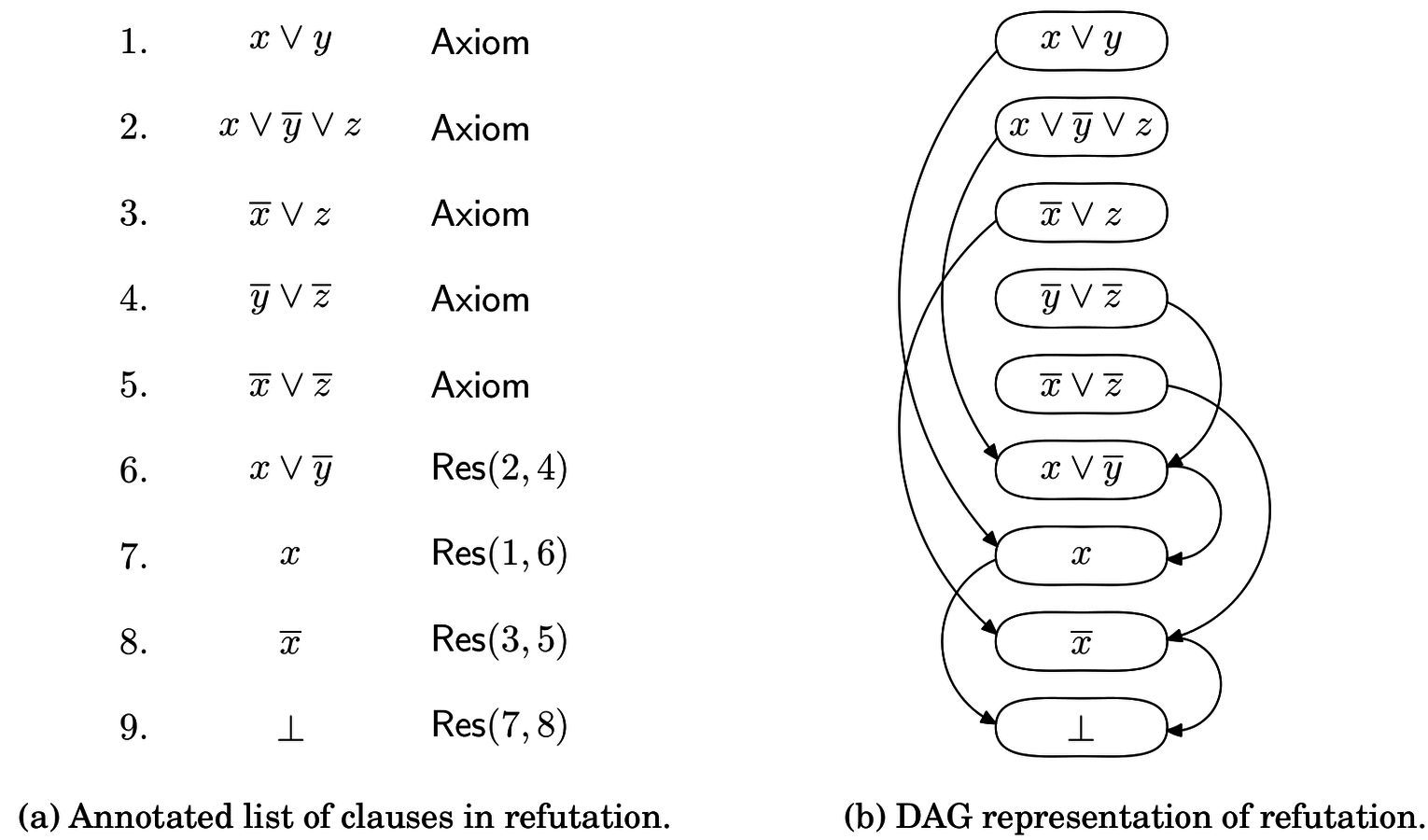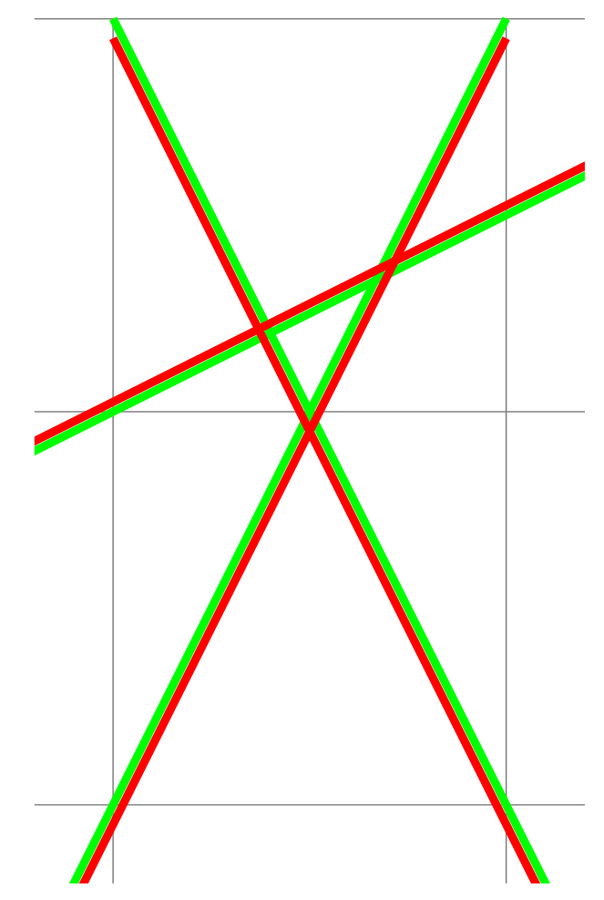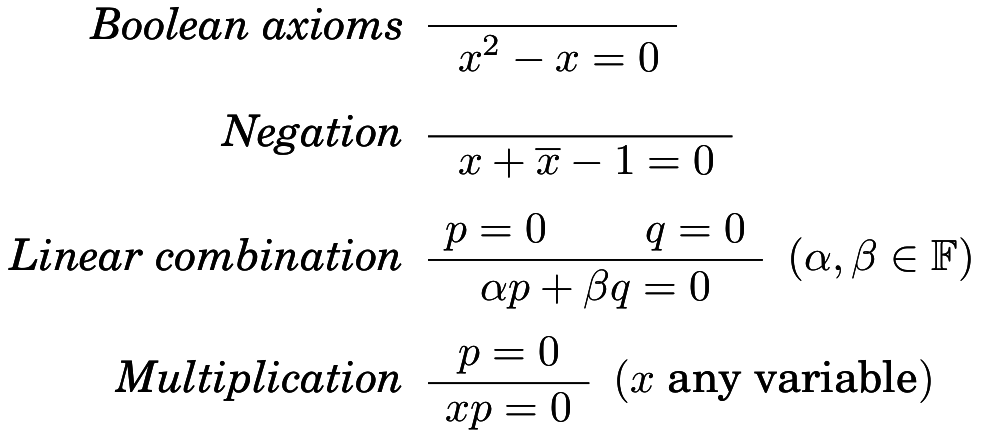Proof Theory
Historical Perspective and Current Research
DTAI seminars
Jo Devriendt
Contents ...
Disclaimer ...
What is a proof?
- List of true axioms
- List of inferred lemma's
- Contains statement to be proven
Informally
- Axiom: All men are mortal
-
Axiom: Socrates is a man
- Inferred lemma: Socrates is mortal
What is a proof?
In this presentation:
propositional refutation
- Propositional theory T
- Derived propositions φ
- Inconsistent proposition (⊥ or 0 ≥ 1 or 1=0)
a \Rightarrow b
\neg c
a
b \Rightarrow c
b
\bot
c
What is a proof system?
- Language to write statements
- Syntactical inference rules
Informally
- Propositional clauses
- Resolution rule
\frac{C \vee p \;\;\;\; D \vee \neg p}{C \vee D}
C = a \vee \neg b \vee c
Resolution proof system
Resolution proof system

Extended resolution proof system
- Resolution:
- Variable introduction:
\frac{C \vee p \;\;\;\; D \vee \neg p}{C \vee D}
\frac{}{\neg p \vee C \;\;\;\; \forall l \in C:\; \neg l \vee p}
Cutting plane proof system
- Linear inequalities:
- Inference rules:

a_1x_1+a_2x_2+a_3x_3 \geq A \;\;\;\; a_i,A \in \mathbb{Z}, x_i \mapsto \mathbb{Z}
Cutting plane proof system

- -2x + y ≥ 0 (axiom)
- x + -2y ≥ -2 (axiom)
- 2x + y ≥ 2 (axiom)
- 2x + -4y ≥ -4 (2*2)
- -3y ≥ -4 (1+4)
- -y ≥ -1 (rounding of 5)
- 2x ≥ 1 (3+6)
- x ≥ 1 (rounding of 7)
- -2x ≥ -1 (1+6)
- -x ≥ 0 (rounding of 9)
- 0 ≥ 1 (8+10)
Polynomial calculus proof system
- Polynomials:
- Inference rules:
x\bar{y}+z=0 \;\;\;\; x,\bar{y},z \mapsto \mathbb{F}

Polynomial calculus proof system
Propositional context:
- = GF(2)
- true = 0
- false = 1
- Derive 1=0
\mathbb{F}
x \vee \neg y \vee z \; \leftrightarrow \; x\bar{y}z=0
Comparison of proof systems (1)
-
proof system A p-simulates proof system B
iff there exists a polytime algorithm transforming B-proofs in A-proofs- A ≥ B
- A "is at least as strong as" B
- RES ≤ CUTPLANE ≤ ERES
- RES ≤ POLYCALC
RES ≤ CUTPLANE

\frac{x + (1-y) + z \geq 1 \;\;\;\; (1-y)+(1-z)\geq 1}{x+(2-2y)\geq 2}
x \geq 0
\frac{\;\;\;\;\;\;\;\;\;\;\;\;\;\;\;\;\;\;\;\;\;\;\;\;\;\;\;\;\;\;\;\;\;\;\;\;\;\;\;\;\;\;\;\;\;\;\;\;\;\;\;\;\;}{2x+(2-2y)\geq 2}
\frac{\;\;\;\;\;\;\;\;\;\;\;\;\;\;\;\;\;\;\;\;\;\;\;\;}{x+(1-y)\geq 1}
(b) Corresponding cutting plane derivation
RES ≤ POLYCALC


Comparison of proof systems (2)
- Proof size: number of steps in proof
- Lower bounds exist!
- Pigeonhole formula
- exponential lower bound - RES and POLYCALC
- poly proof exists - CUTPLANE and ERES
- Tseitin formula
- exponential lower bound - RES
- poly proof exists - POLYCALC and ERES
- Pigeonhole formula
Comparison of proof systems (3)
- RES < CUTPLANE ≤ ERES
- RES < POLYCALC
Combinatorial solvers with "learning"
are
Proof generators
- SAT, SMT, PB, CP
- Lower bound on runtime complexity by lower bound on proof size!
What proofs are generated?
Conflict Driven Clause Learning
while(true){
if(theory contains ⊥){
return UNSAT
}else if(model found){
return SAT
}
branch
(reasoned) propagate
while(conflict){
resolve conflict clause to learned clause
backjump
add learned clause to theory
(reasoned) propagate
}
}Conflict Driven Clause Learning
CDCL "p-simulates" RES
- Reason clause for each propagation
- Conflict clause is unsat
- can be resolved with reason clauses
- constructs resolution proof
Where are the stronger proof systems?
-
Polynomial calculus
- PolyBoRi
-
Cutting planes
- IntSat
-
Extended resolution
- GlucosER
IntSat
- Solves integer program (set of "cutting planes")
- Treats clauses as pseudoboolean cp
- Reason cp
- Learned cp derived from conflict cp
- linear combinations
- roundings
IntSat
- x + y - z ≥ 3 (theory)
- x + y + z ≥ 6 (theory)
- 2 ≥ y (branch)
- 2 ≥ x (branch)
- 1 ≥ z (propagation from 1)
- z ≥ 2 (propagation from 2)
- CONFLICT!
- derive 2x+2y ≥ 9 (derived from 1+2)
- learn x+y ≥ 5 (rounded from 8)
- Learned cp prevents conflicts!
- Learned cp is stronger than x≥3 v y≥3
- But...
IntSat
Problematic learned cp's
x+y+2z \leq 2
y - 2z \leq 0
0 \leq x
1 \leq y
x+2y \leq 2
Does not avoid conflict...
Conflict over z!
2z \leq 1
1 \leq 2z
(z is integer)
Proposed learned constraint:
Branching
choices
IntSat
- Solves integer program (set of "cutting planes")
- Treats clauses as pseudoboolean cp
- Reason cp
- Learned cp derived from conflict cp
- linear combinations
- roundings
- Also backup CDCL!
- Reason clause
- Conflict clause
- Learned clause
- Forgets learned clause
after backjump
IntSat
while(true){
if(theory contains 0≥1){
return UNSAT
}else if(model found){
return SAT
}
branch on variable bound
(reasoned) propagate
while(conflict){
add learned cutting plane to theory
resolve conflict clause to learned clause
backjump on learned clause
(reasoned) propagate
}
}Structure-based Extended Resolution in CP
- Introduce partial sums for linear terms:
- Only when needed ("lazy")
- Connection to ERES!
- Exploit bounds on partial sums in reason clauses
\sum_{0\leq i \leq n} a_ix_i = [\sum_{0\leq i \leq n-1} a_ix_i] + a_nx_n
Structure-based Extended Resolution in CP
- Adding [x+y] as a variable to the CP engine allows for shorter learned clauses.
- ([x+y] ≥ 5) instead of (x≥3 v y≥3)
- IntSat seems to generalize this!
- [x+y] - z ≥ 3 (theory)
- [x+y] + z ≥ 6 (theory)
- 2 ≥ x (branch)
- 2 ≥ y (branch)
- 1 ≥ z (propagation from 1)
- z ≥ 2 (propagation from 2)
- CONFLICT!
- derive [x+y] ≥ 5 (from negation of 3 and 4)
IDP4: Maybe both?
while(true){
if(theory contains 0≥1 or ⊥){
return UNSAT
}else if(model found){
return SAT
}
branch on atom / variable bound
(reasoned) propagate
while(conflict){
add learned cutting plane to theory
add learned clause to theory
backjump on strongest of learned clause
and learned cutting plane
(reasoned) propagate
}
}Questions?
Thanks for your attention!
Literature references available upon request
On Proof Theory
By Jo Devriendt
On Proof Theory
DTAI presentation
- 1,759



